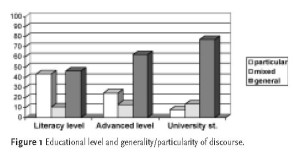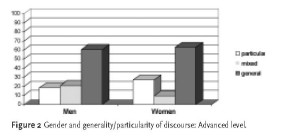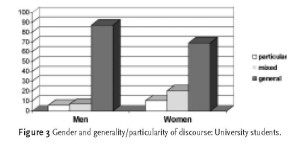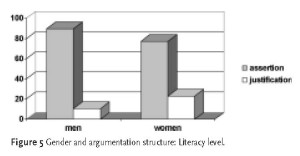ISSA Proceedings 2002 – School Experience, Modes Of Discourse And Argumentation: A Comparative Study Of Women And Men
No comments yet In this paper, we intend to stress the argumentative or rhetorical dimension of human thinking.
In this paper, we intend to stress the argumentative or rhetorical dimension of human thinking.
Traditionally, studies about thinking have analysed problems that are fairly similar to those employed in the field of logic. In these problems, people must arrive at the only possible solution by applying a set of rules. However, we assume that this approach to thinking ignores a series of problems and situations that cannot be solved by one single solution as, for example, when we hold an opinion (Billig, 1987).
One of the main objectives of this study is to analyse some of the argumentative mechanisms that we use to defend our ideas. By using these mechanisms people criticise positions that are different from their own and justify them when these positions are criticised or when people suggest criticisms. In contrast, the most strongly held beliefs are usually presented without justification (Perelman & Olbrechts-Tyteca, 1994).
Toulmin (1958) and Jonsen and Toulmin (1988) differentiate between two kinds of arguments: substantial or practical arguments and theoretical or analytical arguments. The first form includes the cases in which a conclusion that is not necessary deduced from the premises is inferred from them. In the analytical argument, on the other hand, a general conclusion is necessary deduced from the premises. So, while analytical arguments are based upon universal asserts and principles that makes us arrive at universal truths, practical arguments work with probabilities and depend on context. These two forms of arguments correspond to formal logic, on the one hand, and to everyday reasoning, on the other. Validity is approached by different ways. While in the first type it is reached through the deductive form of the argument, practical arguments are validated on the basis of their content. According to Toulmin, Rieke and Janik (1979), in deductive arguments conclusion adds no new information to premises. Conversely, the persuasive strength of everyday arguments rests upon the new information provided by the conclusion.
The difference between these two kinds of arguments resembles Bruner’s (1986, 1996) distinction between logical-scientific or paradigmatic versus narrative thinking. For this author, there are two modes of thinking, which posses their own functional principles and correction criteria. Both forms can be use to convince, but they differ in their procedure of verification. While paradigmatic thinking intends to provide formal and empirical proofs that may convince of their truth, narratives convince by their resemblance to life. So, the first type pursues increasing levels of abstraction in search of general causes, while narrative thinking deals with narratives construction by using situations and characters that result verisimilar. On the other hand, Perelman and Olbrechts-Tyteca (1994) points out that it is generally assumed that, while argumentation is used to convince the others, to convince ourselves we reserve logic. In contrast to this idea, they set a clear relation between argumentation and thinking or, in more precise terms, between argumentation and individual deliberation. Quoting Isocrates, they claim: “the arguments we use to convince other people are the same we use to deliberate”(Perelman and Olbrechts-Tyteca, 1994, p. 87). Agreement with oneself is a particular case of the agreement with others, so that in order to know deliberation proceses we may analyse argumentation directed to others.
Billig’s (1987) ideas regarding argumentation and thinking are closely related to our discussion. He claims that thinking must be conceived in social and dynamic terms, by assuming its connection to argumentation. Thinking posses a dialogic character. It is possible to know the way we think by analysing the way we argue. The idea that thinking has a social origin led him to defend that learning to argue may be critical for learning to think.
According to Billig (1987, 1991) thinking oscillates between particularization and categorization. Categorization refers to the processes by which an element is included within a general category. So, instead of being conceived as a unique and individual entity, each element is treated as one out of a set. Particularization is the opposite principle. According to this principle, each element is considered on the basis of its own idiosyncrasy or peculiarity. Billig asserts that these two strategies for arguing and thinking, categorization and particularization, are complementary. It means that one does not substitute the other.
The contributions of socio-cultural psychology about the relationship between the activity setting of formal education and the processes of abstraction and categorization are especially interesting. Let’s present these ideas in more detail.
One of the topics that has received more attention from the socio-cultural approach is the relationship between formal education and the modes of discourse and thinking associated to this socio-cultural setting. Several studies have analysed this relationship (Cole & Scribner, 1974; Rogoff, 1981; Scribner, 1977; Scribner & Cole, 1981). Many of them have shown that formal schooling privileges the use of an abstract and decontextualised speech genre, the so-called “rational discourse” (Wertsch, 1987).
According to Wertsch and Minick (1990), the features of rational discourse in school are related to the use of “text-based realities” in this setting. This concept refers to a specific form of object created and maintained through discourse. One of the characteristics of text-based realities is the fact that they impose narrow limits on participants so that reference to everyday experience remains beyond these boundaries. The other feature is that text-based realities are related to the use of decontextualised semiotic signs.
Against this form of discourse we find “contextualised forms of representation” (Wertsch, 1987). In these forms, objects and events are represented in terms of their specific particularity.
School, as we have said, privileges the use of abstract and decontextualised discourse. In these settings modes of discourse that focus on the individual experience of people are sanctioned. In contrast, discourses referred to abstract categories are considered more convincing. They elicit more approval than discourses linked to the individual experience of the person that utters them. Thus, we might expect that the use of these modes of discourse increases as the school experience increases. However, it does not mean the substitution of one form of discourse for another, but the possibility of using different forms of representing the environment and acting on it depending on the context in which the person is involved.
It is possible, thus, that several versions of the same event may coexist in the same person.
On the other hand, it is important to note that mediational means not only provide opportunities for the emergence of new modes of thinking. Just as they facilitate or make possible, mediational means also impose restrictions on our attempts at understanding the world and acting upon it (Wertsch, 1998).
The individual privileges one form of discourse or another depending on the activity setting. But even within one setting which privileges this form of decontextualised discourse and with people that master it, there are always examples of use of forms of discourse related to particular situations, whether personal or someone else’s.
As for the relationship between gender and discourse, there is no unanimous view within gender studies. Some authors remark on the differences between women and men. An example of this position is the work by Deborah Tannen (1990, 1994). This author claims that communication between men and women is cross-cultural. She notes that while men prefer public speech (or informative conversations), women use predominantly private discourse (or affective conversations). According to Tannen, women conceive the public arena as an extension of the private world. This would explain why women show a preference for referring to their personal experience rather than to abstract arguments, even in public settings. In the same way, the work by Gilligan (1982) about moral development showed two different voices for dealing with a problem. While boys tried to solve the moral dilemma by using general rules, girls tried to solve it by identifying with the particular situation and with the people involved. These results might be interpreted in terms of differences between men and women and support the idea that women’s ways of thinking are less decontextualised and more linked to concrete situations.
However, authors like Mary Crawford (1995) assert that the approach to difference does not take into account the variability of discourse between women and men. As this approach does not contemplate within-individual variability, neither does it take into account within-group differences. Men and women are considered as homogeneous groups, so that the differences between their discourses are usually attributed to gender only, without taking into account that this variable may co-vary or interact with other factors. School experience may be one of these factors.
This is one of our basic aims: to characterise these speech genres and relate them to school experience and gender. So, we asked women and men from different educational levels to participate in discussion groups in order to understand how school experience and gender were related to modes of discourse and argumentation.
Method
Participants: Women and men participated in this study; they came from three different educational levels: literacy level, advanced level in adult education and university students.
Procedure. The study consisted of several phases:
So, in order to analyse the way in which educational level and gender relate to each other, a study in which women and men from different educational levels were asked to participate in two debates. The topics of the debates were women’s work at home and out of home and children’s rearing practices and education.
Results
In order to facilitate the understanding of the results, we are going to present first the categories employed in the analysis of the ways of discourse and the results obtained from these analyses, and then the categories and the results from the analyses of argumentation.
CATEGORY SYSTEM: Generality vs. particularity of discourse
We are going to present part of a broader work, so we focus in some of the aspect of the dimension of discourse we analysed. One of the dimensions was the degree of generality versus particularity. Each utterance or speaking turn was classified as
1.1 Particular (P); Discourse referred to a specific situation, either of the individual or someone else’s.
1.2 General (G); The subject of the utterance is neither a specific person nor his/her personal situation. The topic/theme of the description or the opinion is a group of people (women, mother, unemployed men, etc.), a situation that does not correspond to any specific person (there are some cases in which women…), hypothetical cases (if you had to do…), as well as cases in which interlocutors are speaking of abstract
concepts (education, society, etc.). In short, general discourse refers both to situations that are explicitly general and to others that lack specificity.
These two modes of discourse may appear together in the same utterance. We categorize this form as mixed.
Regarding this dimension, data showed that participants’ discourse was similar or different depending on educational level. As the educational level increased, particular ways of discourse decrease and ways of discourse separated of concrete situations were more used. As we have said, school experience was the factor related to differences between participants’ discourse, so that all discussion groups of women were more similar to men from the same educational level.
As we have said before, in school an abstract and decontextualised way of discourse is privileged. At the same time, forms of discourse that rely on particular experiences are sanctioned or, at least, are not encouraged. Our debates were carried out within a school setting. Participants might have used the tools privileged in this kind of setting. The more they had participated in these activities, the more frequently used abstract and decontextualised ways of discourse.
It is important to remind that the ways of discourse we use make possible some modes of thinking. So, ways of discourse that are more general and independent from non-egalitarian personal experiences (as we observed in the literacy level) might let people adopt more egalitarian perspectives.
On the other hand, although women’s and men’s ways of discourse form each level were similar with respect to the generality/particularity dimension, we found some relevant differences.
In the literacy level it was the only case were differences between men and women’s discourse were not found. However, in the advanced level discourse referred to particular experiences was more frequent in women’s discussion group (see figure 2).
At the same time, men form the university students’ group used abstract and general discourse more frequently than women from the same group. Conversely, mixed discourse, that incorporated examples within generic discourse and established a relationship between general ideas and concrete experiences, was more frequently employed in the group of women (see figure 3).
Relying on these results, we can say that as the educational level of participants increased, more differences between the level of generality/particularity of discourse. Data suggest that women prefer to introduce our own or someone else’s personal everyday experience, as shown by the fact that women from the advanced level included more concrete examples within discourse referred to general cases than men form the same level.
It is important to remark that these data do not indicate that women does not master a more abstract way of discourse which permit us analyse a given phenomenon by going beyond particular personal experience. Te issue is not inability, but semiotic preference. In this sense, we can remind that general discourse was the predominant form used by women from the highest educational levels. In sum, although women are able to master the abstract discourse that is privileged in school, we prefer to include our personal relations and experiences in discussion.
However we must again emphasise that groups were similar and different in their discourse mostly depending on the educational level of the participants. Thus, although we found differences between women and men, women from each educational level tend to resemble men from the same level more than women from a different one.
Justification: another aspect that we analyse was
The second dimension of discourse that we analysed was the justifications used by participants. We considered whether participants justified their actions or opinions. The categories were the following:
2.1 Assertion (A); Consist of one or several statements in which participants told actions or expressed opinion, without any justification of them.
2.2 Assertion-justification (A-J); In this category we included the utterances in which acts or opinions were justified. These utterances consisted of one or several assertions together with a justification of why the events narrated happened or the opinions expressed were hold. For instance:
Cases in which the assertion was done in a previous utterance, whether by the same or by a different person, were also included in this category. Therefore, what made us score this category was the appearance of a justification. For example:
The data about justification were related to educational level and gender in the same way as the dimensions of discourse analysed above (see figure 4). The fact that participants justified their assertions depended on their educational level. Again, gender was a variable that modulated the relationship between educational level and justification. We shall start by summarizing the results about this relationship.
Men and women from the literacy level were the groups that provided lesser arguments to hold their assertions (see figure 5). They provided reasons to act and to defend their opinions in only the 10 % of their interventions. This conduct can be explained by two factors. First, they might not master the argumentative resources to convince and persuade others. As we have claimed, when a person participate in a debate, s/he tries, as presenting her/his position, to get the others to adhere to it. For this purpose, the speaker must anticipate the criticisms that s/he can receive and, in this sense, to include in the arguments justifications of what s/he says or does. As Aristotle maintained in his Rhetoric, one of the proofs used in argumentation are the enthymemes (rhetoric syllogisms), composed by an assert and its justification. But this kind of rhetoric resource was almost not used in the literacy level. Among other reasons because it demands the speakers not only to master some argumentative skills, but also to be aware of the fact that their perspective is only one among others, which can be also plausible. If, in contrast, they assume that their way of conducting is “the right one”, they would hardly try to justify it. According to Perelman and Olbrechts-Tyteca (1994), the most solid beliefs are usually presented without any justification. For participants, their opinion about domestic work may not incite any controversy, but correspond to common sense.
In contrast, in advanced level we found the highest proportion of justifications. They amounted the 35% of the cases. This let us think that for women and men from this level the topics in discussion were polemical. In this sense, their opinions about them should be accompanied by justifications, intending to avoid the criticisms that these opinions might rise. On the other hand, participants in these groups, specially the women, discussed about these topics in a vehement way, showing the importance of the issues at hand. Look for explanations of their situation was important for them. In some way, when a person tries to explain things, s/he is assuming that things could be different.
In the university students groups we use of justifications was more frequent than in the literacy level, but less frequent than in the advanced level. Maybe because these topics did not raise so much controversy as in the advanced level groups.
On the other hand, to explain why did appear a higher frequency of assertions without justification in the groups from this level, it is necessary to take into account the degree of generality-particularity of discourse. As mentioned, the use of general discourse in this level represented the 77.4% of the cases. That is, the most of utterances produced by university students referred to general situations or events. It means that participants in this group used another critical feature of argumentation for Aristotle: the maxim, that consists of a general assertion. In this rhetorical strategy that is alternative to enthymemes, speakers present a fact or opinion as something that is accepted by a group of people, as an assertion that cannot be doubted at all.
If we try to explain these results, we can point out that school may promote the use of this form of utterances. Knowledge transmitted in school is presented as facts that do not allow be questioned. There are very few cases (if any) in which the official version of the story narrated is questioned. As Cross (1996) points out, “educators become the spokespersons of the values assumed by the community, and they teach their audience and admitted science, that is presented as true and, in contrast to (constructed) science that is constructed, does not admit any controversy” (p. 95).
Finally, results showed that there were no differences between men and women in the use of justifications in the advanced and in the university students level. However, in the literacy level women justified their acts or opinions more than men form the same level. Although the topic was not controversial in this level, however, To explain this fact we can argue that, since in this level the topic was less controversial, for women, however, a was a little more.
On the other hand, in many of the aspects of discourse analysed we have found that participants differ from, or resemble others, depending on their educational level. We therefore think that this variable must be taken into account in any study that analyses or compares discourses produced by women and men. From our analysis we also can gather that men and women do not form homogeneous groups with regard to modes of discourse. Within these groups we have found important differences because of the educational level.
REFERENCES
Billig, M.: 1987, Arguing and Thinking. A Rhetorical Approach to Social Psychology. Cambridge University Press, Cambridge.
Billig, M.: 1991, Ideology and Opinions. Studies in Rhetorical Psychology, Sage, London.
Bruner, J.S.:1986, Actual minds, possible worlds, Harvard University Press, Cambridge, Mass.
Bruner, J.S.: 1996, ‘Meaning and self in cultural perspective’, in D. Bakhurst & Ch. Sypnowich (eds.), The social self. Sage, London.
Cole, M. & Scribner, S.: 1974, Culture and thought: A psychological introduction, Wiley, New York.
Crawford, M.: 1995, Talking Difference. On Gender and Language, Sage, London.
Cros, A. :1995, ‘¿El discurso académico como un discurso argumentativo. El argumento de autoridad en la primera clase de un curso académico’, Comunicación, lenguaje y Educación, 26, 95-106
Gilligan, C.: 1982, In a different voice: Psychological theory and women’s development, Harvard University Press, Cambridge, Mass.
Jonsen, A. and Toulmin, S.: 1988, The Abuse of Casuistry: A History of Moral Reasoning, University of California Press, Berkeley.
Perelman C. y Olbrechts-Tyteca L.: 1994, Tratado de la Argumentación. La nueva retórica, Gredos, Madrid.
Rogoff, B.: 1981, ‘Schooling and the development of cognitive skills’, in H. C. Triandis & A. Heron (eds.), Handbook of Cross-Cultural Psychology (Vol. 4). Allyn and Bacon, Boston.
Scribner, S.: 1977, ‘Modes of thinking and ways of speaking’, in P. N. Johnson- Laird & P. C. Wason. (eds.), Thinking: readings in cognitive science. Cambridge University Press, New York.
Scribner, S. & Cole, M. : 1981, The psychology of literacy. Harvard University Press, Cambridge, Mass.
Tannen, D.: 1990, You just don´t understand me. William Morrow, New York.
Tannen, D.: 1994, Gender and Discourse. Oxford University Press, Oxford.
Toulmin, S.: 1958, The Uses of Argument, Cambridge University Press, Cambridge.
Toulmin, S., Rieke, R. and Janik, A.: 1979, An Introduction to Reasoning. Mcmillan, New York.
Wertsch, J. V.:1987, ‘Modes of discourse in the nuclear arms debate’, Current Research on Peace and Violence, 2-3.
Wertsch, J.V. : 1998, Mind as Action. Oxford University Press, New York.
Wertsch, J. V. and Minick, N.: 1990, ‘Negotiating Sense in the Zone of Proximal Development’, in M. Schwebel, C.A. Maher and N.S. Fagley (eds.), Promoting Cognitive Growth Over the Life Span. Erlbaum, Hillsdale, N.J.
You May Also Like
Comments
Leave a Reply










